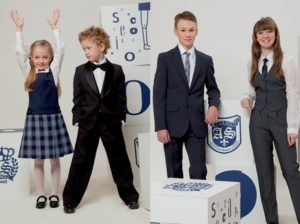Children who did not encounter a school uniform before 2012 are often reluctant to wear them. Today's first-graders, who do not know about the days of “wearing whatever you want to go to school,” have a normal attitude towards appearance requirements. On the contrary, yesterday's T-shirt-clad preschoolers love the feeling of change. Switching to a school uniform seems to them a confirmation of adulthood.
However, regardless of what the child’s opinion is regarding what is happening, he will still have to go to class in business casual clothing. There are several reasons for this.
School dress code - classic look
The dress code for school dictates the following rules: appropriate length of trousers and skirts, absence of bright prints and details in the image, classic cut, restraint of styles and colors.
First of all, you need to learn how to select things that suit your child. Say “no” to out-of-place shoulder lines, ruffled trouser legs, and items purchased “to grow out of.” Due to frequent use, a wardrobe item will lose its appearance before this “growth” occurs.It turns out that you are condemning your son or daughter to constantly wearing ill-fitting clothes. At first it looks like this because it is big, and then, when the child grows up, because it is worn out.
What to wear to school for boys
 Shirt. Most often white, without pockets or with only one breast pocket, with long sleeves. In some establishments, it is acceptable to wear a plain shirt in a muted shade, or a snow-white turtleneck or T-shirt.
Shirt. Most often white, without pockets or with only one breast pocket, with long sleeves. In some establishments, it is acceptable to wear a plain shirt in a muted shade, or a snow-white turtleneck or T-shirt.- Trousers. Classic cut. Possible colors: dark blue and black. Sometimes educational institutions require the wearing of gray trousers or trousers with a classic print (for example, small two-tone ripples or checks).
- Vest or jacket. Some schools wear both items at the same time, while others only require you to wear one.
- Headgear - a gymnasium or lyceum may insist on wearing a universal model.
- Unique insignia for the institution. In some places you should wear ties with a certain print, in other places they require stripes, in others they insist on badges with symbols.
- Shoes. Classic, polished, lace-up, plain. Only elementary school students are exempt.
- Belt. Black or brown in color, without a strange or unusually shaped buckle.
Girl's outfit
 A white blouse or shirt. High school girls should avoid sheer materials and revealing cleavage.
A white blouse or shirt. High school girls should avoid sheer materials and revealing cleavage.- Skirt. Sometimes it is allowed to attend classes in skirts of any model; in other institutions they require you to come only in things of specific styles. Watch the length!
- Sundress. Shouldn't be frivolous.
- Jacket, vest or cardigan.
- Shoes with low heels, polished, plain.
What should you not wear to school?
There is a universal list of requirements and prohibitions, as well as lists that work exclusively within a specific educational institution. First, let's get acquainted with the generally accepted rules. According to them, a boy should not wear the following items to school:
- wrinkled shirts;
- shirts with non-classical prints and stripes (in many establishments any shirts other than white ones are prohibited);
- jeans with informal decoration (for example, ripped, fringed);
- T-shirts with inscriptions and images that are not accepted at school;
- clothing with labels placed in a visible place;
- cropped and simply short trousers;
- pants with pockets located below the traditional places where they are placed.
 You should also not walk around in dirty, heavily wrinkled and torn clothes, or in unpolished shoes - these are the minimum requirements of SanPiN. It is unacceptable to attend classes in shoes or clothing that can harm others or have antisocial symbols. In addition, seasonality should not be ignored. The child must be dressed according to the temperature conditions indoors and outdoors.
You should also not walk around in dirty, heavily wrinkled and torn clothes, or in unpolished shoes - these are the minimum requirements of SanPiN. It is unacceptable to attend classes in shoes or clothing that can harm others or have antisocial symbols. In addition, seasonality should not be ignored. The child must be dressed according to the temperature conditions indoors and outdoors.
Girls, in turn, should not appear at school wearing the following things:
- leggings;
- shorts;
- miniskirts and mini sundresses;
- tops above the waist;
- transparent;
- shiny;
- leather (in addition to upper wardrobe items);
- fishnet tights;
- torn tights;
- shoes with very high heels.
 As mentioned above, each educational institution has the right to prescribe in its internal documents additional requirements for the dress code of students. For example, in some schools and lyceums it is unacceptable to wear a sundress to classes. The taboo applies not only to frivolous models, but also to things of a discreet business style. In other institutions, everyone is required to wear ties.Appearing without it or with a bowtie is regarded as a disciplinary violation.
As mentioned above, each educational institution has the right to prescribe in its internal documents additional requirements for the dress code of students. For example, in some schools and lyceums it is unacceptable to wear a sundress to classes. The taboo applies not only to frivolous models, but also to things of a discreet business style. In other institutions, everyone is required to wear ties.Appearing without it or with a bowtie is regarded as a disciplinary violation.
Sometimes the rules are quite strict. The educational institution not only says that you need to wear vests, but also describes in detail in the charter the characteristics of a model suitable for use. Every characteristic is considered - from the fabric to the number, size and color of buttons.
Important! If you do not study the internal documentation of the educational institution in detail, you may inadvertently violate many rules regarding the dress code. Today it is not enough to know about white top and black bottom. It is necessary to meet the expectations of teachers and school administration.
In addition to the internal school regulations, representatives of the future first-grader should familiarize themselves with the results of the first parent-teacher meeting. It is held in advance - not in September - in order to get to know the teacher. The situation with textbooks and workbooks is usually resolved here, representatives of the birth committee are selected and the components of the form are discussed. The issue of ordering the same type of clothing from a specific factory is often put to a vote. If a decision is made and then not followed (the child wears things that were not ordered), then this is also a violation.
Why do schools require students to dress in business casual?
They received the corresponding powers after the adoption of the Federal Law on Education No. 273 of December 29, 2012. Since then, educational institutions can establish requirements:
 to color;
to color;- style;
- size;
- type of clothing;
- to accessories on things;
- to insignia (for example, stripes, badges, ties).
Students, in turn, are required to fulfill these requirements, but only on the condition that they are spelled out in the institution’s charter.Failure to comply will result in various types of disciplinary action, but not removal from classes. Inadmissibility to study under the current law on the need for all citizens to receive secondary education is an administratively punishable violation.
Pros and cons of dress code at school
Advantages (real or perceived):
 girls in tank tops and club outfits disappeared from classes;
girls in tank tops and club outfits disappeared from classes;- children became outwardly socially equal;
- a school uniform allows strangers to understand that there is a student in front of them (that is, to find out the age of a teenager who may look older);
- the strict form sets the mood for a business-like, discreet manner;
- the need to comply with social rules for 9–11 years has a positive effect on the formation of character;
- children get used to looking decent and taking care of their appearance;
- Manufacturers of school uniforms are subject to stricter control than factories producing casual clothing (because things last longer and are safer);
- common characteristics unite the team, make it cohesive and friendly (identity is formed);
- the differences between subcultures are erased, which reduces the level of heterogeneity, aggression and psychological discomfort in the team.
The school dress code is not always stereotyped, dull, sameness and loss of one’s own “I”. Lyceums and gymnasiums often introduce a unique dress code, making it easy for their students to be found among a diverse crowd of children. They look beautiful, stylish and do not fall into the definition of an expressionless, faceless mass.
Difficulties and weaknesses of the dress code:
 School uniforms are a rich field for speculation. Lyceums and gymnasiums often force parents to order things from specific factories.Educational institutions enter into an agreement with them and therefore have a financial interest in this matter. In general education schools the phenomenon is not so common.
School uniforms are a rich field for speculation. Lyceums and gymnasiums often force parents to order things from specific factories.Educational institutions enter into an agreement with them and therefore have a financial interest in this matter. In general education schools the phenomenon is not so common.- The principle of social equalization does not always work. A jacket purchased for 800 rubles and a jacket purchased for 8 thousand do not look the same. A girl who has five sets of school uniforms for a week does not look the same as a student whose parents were barely able to provide their daughter with one skirt and a single sundress for the entire school year.
- Parents have to spend more. Children grow in leaps and bounds and sometimes incredibly rapidly. A teenage boy can stretch more in one week than in the previous two years. This means that after such a leap, his parents will have to update their child’s two wardrobes at once: one ordinary, the second – school. Previously, it was possible to purchase universal items. They were suitable for both weekdays and school.
- Some parents try to save money in every possible way, so they do not pay attention to the safety of the purchased uniform. More precisely, they are simply forced to turn a blind eye to this, which unreliable manufacturers successfully take advantage of. Another non-working advantage of the school dress code.
- A strong negative response to the introduction of uniforms and the situation surrounding the appearance of students arose among people who have a negative attitude towards the USSR. It is difficult to blame them for seeing a connection between what is happening and what happened in the Union. Especially considering the publicized cases of children not being allowed to participate in the educational process because of dyed hair, the wrong length of sleeves on a shirt, or the use of a skirt instead of an approved sundress.
We already went through something similar in the 60s–80s. And the results of reprimands, disciplinary punishments and calling parents to school due to dress code violations were a persistent dislike for educational institutions and a desire to rebel. The stricter the rule, the higher the temptation for some teenagers to break it. And the parents of such children, in turn, sue for unlawful exclusion from classes and deprivation of the child’s right to receive compulsory school education in Russia. Have the uniforms made life easier for students and schools? A very controversial issue.







 0
0





